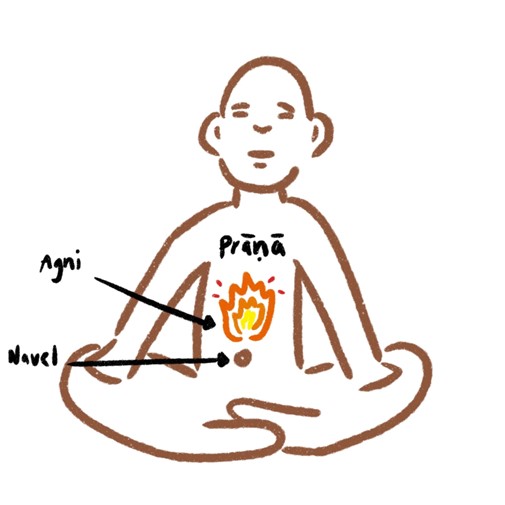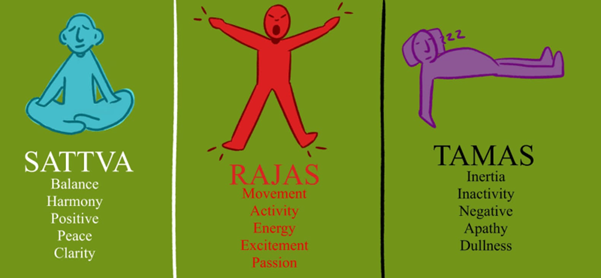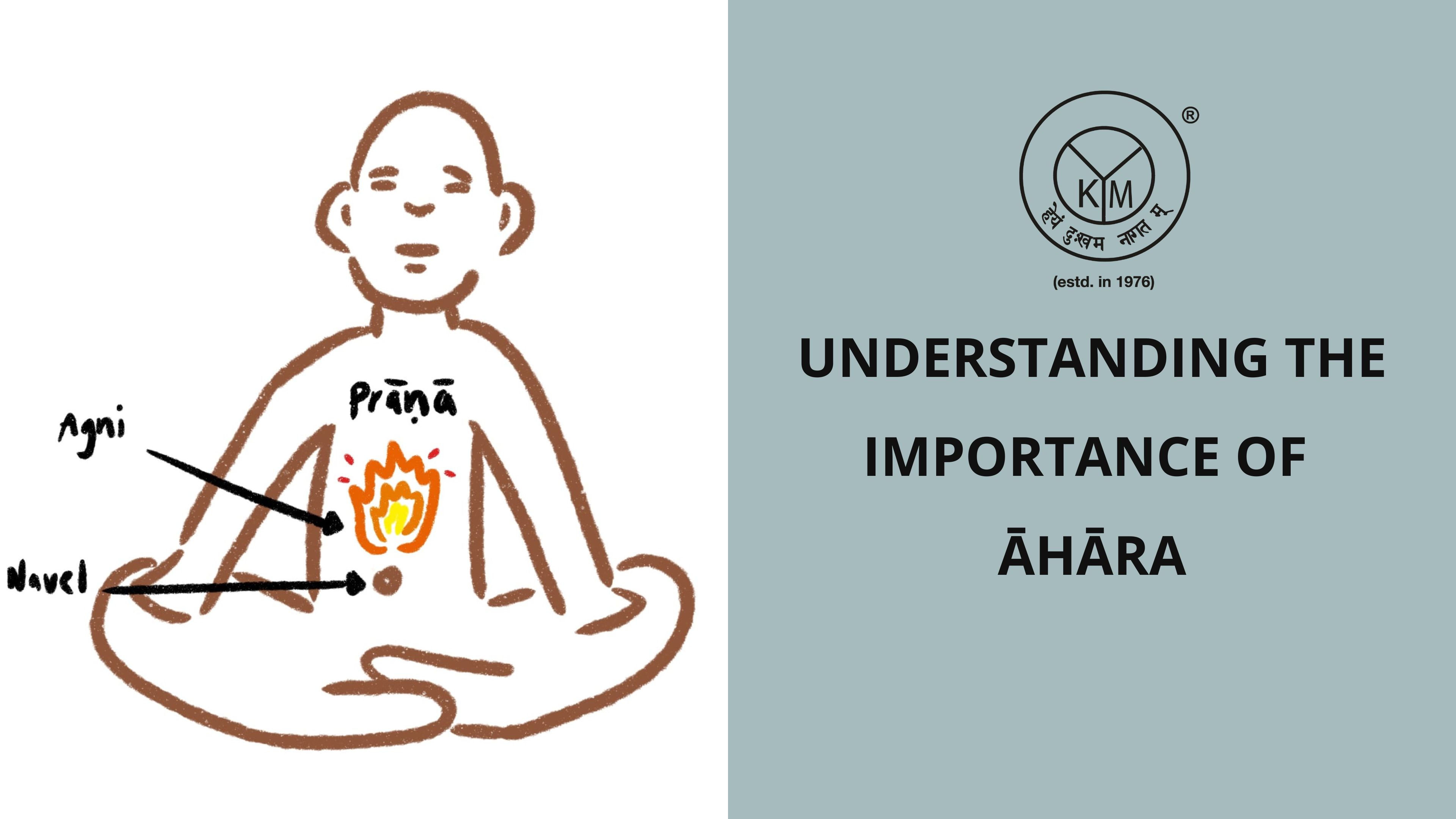Śrī S Sridharan,
Senior Mentor & Yoga Therapist, Krishnamacharya Yoga Mandiram
Introduction
Yogācārya T Krishnamacharya, quite often, emphasizes on the discipline on the food habits and emphatically states that without food discipline the results of Yoga practice can never be achieved fully, particularly ‘mind control.’
There are two Saṁskṛta words for food, viz., Anna and Āhāra.
‘Anna’ comes from the root word is ‘Ad,’ which means, ‘that which nourishes our body’ – ‘Annamaya.’ ‘Adyate atti ca bhūtāni’ – ‘that which is consumed and that which consumes the living beings (T.U, Ānanda Vallī 2:2.2).
In evolution, food evolves from the five major elements (earth, water, fire, wind and space) and herbs/plants (oshadhibhyo’nnam, T.U, Ānanda Vallī 2:2.2) in an order.
‘Āhāra’ also means ‘food.’ The root word is ‘Hŗ’ which means ‘to take away.’ It takes away the hunger and also the life. Food (Anna) from the field where it is grown, reaches the dining table (Āhāra) through a process. At every level it undergoes changes at gross and subtle levels which impacts the physical and mental levels.
At the cultivation level, generally, we have little control. However, experiments of using Vedic Mantra-s and music at the fields have shown that plants react to such sound waves positively.
While cooking, ancients have advised that the cook should have a pleasant mental frame and is encouraged to recite Śloka-s, etc. To offer the food to God, before eating, is an ancient ritual which Yogic texts (like Haṭha-yoga-pradīpikā) advocates.
While eating, certain prescriptions including posture, company of people, mental frame, and maintaining silence are advised. Overall, the aim is to ensure that the food should not only get digested but will also have positively impact on the physical and mental levels.
Āhāra As A Source Of Prāṇa
There are three sources of Prāṇa of which one is Annam (Food), the other two being Āp (water) and Vāyu (air).
(Ref: ‘Prāṇo vā annam’ (T.U- Bhṛgu Vallī). It is Prāṇa which is food. ‘Annena vāva sarve prāṇa mahīyante’ (Taittirīya Upaniṣad 1.5.5) All the Prāṇa-s are sustained by ‘Annam’ (food). ‘Prāṇo hi bhūtānām āyuh’ (T.U- Ānanda Vallī). Prāna is the life force and it determines our lifetime.
Also, Prāṇa gives health. Vitiation of Prāṇa (Prāṇa Prakopa) is the cause of illness. It is Prāṇa which heals. Finally, it is Prāṇa which helps in ‘Self-realisation.’ When Prāṇa is in ‘Suṣumṇā Nāḍī, the stability of mind (Samādhi) is achieved.
Pañca Prāṇa-s Role in Digestion
Prāṇa has important role in the digestion and assimilation of the Āhāra (food). Prāṇa brings in the fuel, governs the intake of substances. Samāna converts this fuel to energy, governs their digestion. Vyāna circulates the energy to the various work sites, governs the circulation of nutrients. Apāna releases the waste materials or by products of the conversion process, governs the elimination of waste-materials. Udāna governs the positive energy created in the process and determines the work that the machine is able to do.
Digestion
Digestion is the most important aspect of consumption of food. Improper digestion results in non-absorption of nutrients and leaves toxins (Āma) in the system. For proper digestion, the Jāṭarāgni (fire) and the Samāna Vāyu in the system should be in a good condition. Toxins in the system will put down the fire and thus result in improper digestion. Improper food will also create toxins in the system. Example, eating food that was cooked over three hours. Excess eating (Atyāhāra) can also cause indigestion and thereby leave toxins.

How Digestion Takes Place?
Agni + Prāṇa + Apāna
By a fire inside the body (near navel) called ‘Jāṭarāgni’ and ‘Vaiśvānaragni.’
‘Ayam agnir vaiśvānaro yo’yam antaḥ puruṣe, yenedam annam pacyate’
“The fire inside the stomach is the Supreme Vaiśvānara Himself. He is the Puruṣa within. By Him, the food that is taken is digested.” (Brahadāraṇya Upaniṣad 5.9.1)
अहं वैश्वानरो भूत्वा प्राणिनां देहमाश्रित: |
प्राणापानसमायुक्त: पचाम्यन्नं चतुर्विधम् ||
ahaṁ vaiśhvānaro bhūtvā prāṇināṁ deham āśhritaḥ
prāṇāpāna-samāyuktaḥ pachāmy annaṁ chatur-vidham ৷ (Baghavad Gītā.15.14)৷৷
I, taking the form of Vaiśvānara and residing in the bodies of creatures, in association with Prāṇa and Apāna, digest the four kinds of food. These consist of foods to be chewed, sucked, licked and drunk.
Practice of Yoga, particularly Prāṇāyāma helps in making the Agni (fire) in the stomach steady and thereby ensuring proper digestion. Improper digestion which leaves toxins in the body is the cause of all illnesses.
Āhāra and Mind
How food is associated with our Mind?
अन्नमयंहि सोम्य मनः annamayaṃhi somya manaḥ (Chandogya Upaniṣad 6.5.4)
O beloved one, mind is surely made of food
अन्नमशितं त्रेधा विधीयते तस्य यः स्थविष्ठो धातुस्तत्पुरीषं भवति यो मध्यमस्तन्मांसं योऽणिष्ठस्तन्मनः ॥ ६.५.१ ॥annamaśitaṃ tredhā vidhīyate tasya yaḥ sthaviṣṭho dhātustatpurīṣaṃ bhavati yo madhyamastanmāṃsaṃ yo’ṇiṣṭhastanmanaḥ || Chandogya Upaniṣad 6.5.1 ||
Food when eaten gets divided in three ways. Of it, that which is the grossest ingredient turns into feces. That which is the medium constituent becomes flesh. That which is the subtlest becomes mind.
From the above Upaniṣad statement the close link between food and mind can be seen. If the food is impure the mind will also be impure. The impurity in the mind is caused by the excess of the two Guṇa-s, viz., Rajas and Tamas.
Hāra and Āhāra
The story of a Saint and the jewel from the Veda-s, is a wonderful example for the connection between Āhāra and Mind. The Saint, who is the King’s Guru, who lives in an Āśram outside the city, visits the King at his request. The King provides the Queen’s special room for the Saint to stay. The Saint partakes food from the royal kitchen. After the return of the Saint, the Queen reports that her special necklace is lost. The King announces reward for anyone who finds the special necklace. The Saint informs the King that the special necklace is with him. Surprised at how the necklace has gone with the Saint, the King requests the Saint to explain the happening. The Saint calls for the cook of the royal kitchen and asks him to find out the source of the rice. It was found that the rice is a stolen rice. The Saint says that the corrupt mind of the thief who had given the rice has been responsible for his mind turning to become corrupt.
This story gives the importance of how Āhāra passes on the characteristics of those who procure, cook, serve and even the company of those while eating.
Ahāra and the Triguṇa-s
The mind is made up of the three Guṇa-s. Bhagavadgītā divides the food into three based on the impact it makes on the Guṇa-s.

Food for Sāttvika Beings | Bhagavadgītā Chapter 17 Śloka 8
आयुःसत्त्वबलारोग्यसुखप्रीतिविवर्धनाः।
रस्याः स्निग्धाः स्थिरा हृद्या आहाराः सात्त्विकप्रियाः।।17.8।।āyuḥsattvabalārōgyasukhaprītivivardhanāḥ.
rasyāḥ snigdhāḥ sthirā hṛdyā āhārāḥ sāttvikapriyāḥ৷৷ 17.8 ||
Foods which promote longevity, intellectual alertness, strength, health, pleasure and happiness and those that are sweet, oil, substantial and agreeable, are dear to Sāttvika beings.
Food for Rājasīka Beings | Bhagavadgītā Chapter 17 Śloka 9
कट्वम्ललवणात्युष्णतीक्ष्णरूक्षविदाहिनः।
आहारा राजसस्येष्टा दुःखशोकामयप्रदाः।।17.9।।
kaṭvamlalavaṇātyuṣṇatīkṣṇarūkṣavidāhinaḥ.
āhārā rājasasyēṣṭā duḥkhaśōkāmayapradāḥ৷৷17.9 ৷৷
Foods that are bitter, sour, very salty, exceedingly heating, very pungent, dry and burning, are all dear to Rājasīka men; they produce pain, sorrow and disease.
Food for Tāmasika Beings | Bhagavadgītā Chapter 17 Śloka 10
यातयामं गतरसं पूति पर्युषितं च यत्।
उच्छिष्टमपि चामेध्यं भोजनं तामसप्रियम्।।17.10।।
yātayāmaṅ gatarasaṅ pūti paryuṣitaṅ ca yat.
ucchiṣṭamapi cāmēdhyaṅ bhōjanaṅ tāmasapriyam৷৷ 17.10 ৷
That food which is stale (more than three hours), tasteless, putrid (bad smelling), decayed, refuse (remnants of food eaten by others), unclean, is dear to Tāmasika men.
Āyurvedic Approach
स्नानस्य अन्तरं आहारः सेवनीयः | snānasya anantaram āhāraḥ sevanīyaḥ।
One should eat food after bathing.
पूर्वाहारे जीर्णे सति आहारः सेवनीयः pūrvāhāre jīrṇe sati āhāraḥ sevanīyaḥ।
Only after the digestion of meal eaten earlier one should eat food.
हितः मितः च आहारः सेवनीयः। hitaḥ mitaḥ ca āhāraḥ sevanīyaḥ।
One should partake food that is beneficial, and one should follow moderation.
Food Divided According to the Prakṛti of the Individual as Per Āyurveda
Vāta Prakṛti
- Sweet, sour and salty food generally good
- Grains: Well cooked rice and wheat (heavy). Millets, corn tend to be drying – occasionally to be used
- Cooked vegetables better than raw vegetables
- Okra, beans, carrots, sweet potatoes
- Avoid potatoes, tomatoes, eggplant if suffering from muscle ache
- Fruits: Bananas, berries, cherries, dates, figs etc
- Sweet, sour and salty foods are generally good
Pitta Prakṛti
- Sweet, bitter and astringent are good and avoid sour, salty and pungent foods
- Grains: Rice and barley. Millet and corn occasionally. Yeasted bread is not good
- Vegetables: Avoid sour tomatoes and radishes. Recommended are cabbage, cucumber, and greens
- Fruits: Grapes, mangoes, melons, oranges and dried fruits
Kapha Prakṛti
- Bitter, pungent and astringent. Avoid sweet, sour and salty.
- Grains: Millets are best. Rice and wheat preferred.
- Vegetables: All good. Avoid Potatoes and Tomatoes.
- Fruits: Avoid very sweet and very sour fruits.
Ahāra Niyama for Yoga Practitioners
- Certain pre-requisite in the form of disciplines to be followed are prescribed in the Yogic texts, particularly for those who are practitioners and have not reached higher stages.
- One of such disciplines relates to ‘Āhāra.’ What food stuffs are conducive to the practice of Yoga and what are required to be kept off?
- Hita Mita Ahāra so says both Āyurveda and Bhagavadgītā.
- Hita – suitable and conducive; Mita – moderate and right quantity.
- ‘Hita’ – beneficial, wholesome and talks of ‘quality.’
- ‘Mita’ – measured, limited and talks of ‘quantity.’ Food half the stomach, the balance half is divided into two. Half is for the water and the balance half left for air (Āyurveda).
- “Makes the body light, no excess flesh accumulates (stomach). Makes mind”
- Reheated food is to be avoided. Offering the food to God before eating is recommended.
- Recommended food for Yogis: Wheat, rice, barley, purified food, milk, ghee, brown sugar, butter, sugar candy, honey, dry ginger, green gram and pure water.
- Āyurveda recognizes six Rasa-s (tastes). They are bitter, sour, pungent, salt, sweet and astringent. Of these only sweet and astringent are recommended.
- Essentially food that is Sāttvic is recommended, avoiding Rajasic and Tamasic.
Conclusion
Āhāra plays an important role in the physical and mental health of individuals. For Yoga practitioner discipline in food is very important to ensure healthy life to pursue Yoga practices and achieve the highest spiritual goals.
Let us be very careful about Āhāra.

